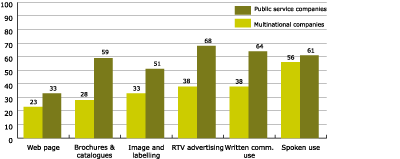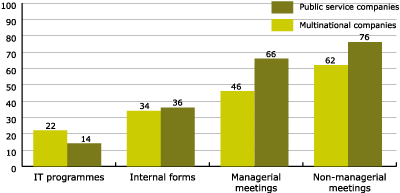
| Winter 2005 |
Language policy in multinational and public service companies in Catalonia, by Joan Solé Camardons, Jonatan Castaño and Agustí Díaz |
||||
Summary 1.
Introduction 2. Language
use and criteria 3. Language
attitudes 4. Interest
in language services 5.
Variables that affect language use 6. Language
policy for the multinationals and public service companies
Catalan is one of 6.000 languages spoken around the world, and compared with other stateless languages, we could say that it is in good health - while at the same time it is clearly not one of the important languages of international expression in the new economy. In a globalised world, as Arnaud Sales says (2004) “what alters the status of languages on an international scale and facilitates the predominance of English, has to do, above all, with the breaking of the cultural space protected by the nation states”, but that applies obviously when looking at those languages which have traditionally been protected by the nation state. The situation that Catalan finds itself in, on the other hand, is something else, given that Catalan has not been protected historically by the Spanish state and has even been discriminated against, at times, in favour of Spanish. By this means it was thought to achieve union and homogeneity within the borders, making Spanish the language protected by the state in the economic and international arenas. Thus, it seems a priori that neither the formation of the nation state, nor the process of globalisation and the concentration of capital, germane to our economic system, makes it easy for Catalan to achieve normalisation and parity in the world of multinational companies. In June 2003, an international colloquium was held on language use in companies operating on an international scale, organised by the Generalitat de Catalunya and the Government of Quebec. With this as the framework, a series of studies were presented on patterns of language use in Catalonia, Quebec and the Basque Country. This article takes a closer look at the data obtained in Catalonia. The Llei 1/1998 de política lingüística (1998 Language Policy Act) lays down in article 31: “1.Companies and public or private entities that offer public services, such as public transport, supplies and deliveries, communications and others, must use at least Catalan in signs and notices and announcements over public address systems. 2. Written communications and notifications addressed to persons resident in Catalonia by companies and organisations referred to in subsection 1, including invoices, bills and other similar documents, should / must be at least in Catalan, without infringing the right of citizens to receive the same in Spanish if they request it. 3. The directive in subsection 2 relating to invoices and similar documents is to be understood as not infringing the State's competence or right to organise such services when supplied directly or via their own companies and entities /organisations.” In accordance with this regulation, a survey was carried out in 2003 by means of the Indexplà (Alfrd Castells, "Indexplà. Programme for evaluation of organisations" Noves SL, Summer 2003) questionnaire administered to public service companies to ascertain the state of their language use. The main results obtained are presented in this article. This article sets out to capture the sociolinguistic situation in two economic settings the multinationals and the public service companies operating in Catalonia. Differences and similarities are looked at and the variables that have most influence on levels of Catalan use are determined, in the two types of companies. Determining this is of fundamental importance if we want to achieve normalisation of Catalan (that is, its established use in all ambits) by acting upon the correct variables. 1.2 Sources of information and methodology The table below summarises the characteristics of the two studies which provided the data treated in this article.
1.3 Techniques of analysis used In the preparation of this article we drew on two sociolinguistic studies carried out by the Institut de Sociolingüística Catalana (ISC) of the Generalitat de Catalunya. The studies in question were: the Survey on Language Use in Public Institutions (Enquesta sobre Usos Lingüístics a Institucions Públiques) (EULIP) and the study on Language Use in big companies in Catalonia (Usos lingüístics a les grans empreses presents a Catalunya). As can be seen from the technical details given above, these two studies utilise two different methods of data collection, have different samples and furthermore one or two of the variables in common across the two studies have been measured in different ways. As a result, we needed to make an effort to render the data more homogeneous to present comparable data wherever possible, something that did not always prove possible. In addition to the quantitative comparisons we put forward an explanatory model relating to which variables most influenced use in each type of company. To do this an analysis was carried out of the variance of all the variables under study in order to see which of these were significant at 95% rate - those, in other words that had considerable effect on (use of) Catalan. After that, the C&RT (1), technique was applied to the variables that emerged as significant. The latter uses segmentation trees to represent the explanatory model in a very graphic way, showing the variables that discriminate most in terms of Catalan use. In the six areas of communication submitted to analysis in both types of company,Catalan showed a higher level of use in the public service companies than in the multinationals. Notice that in spoken use, use of Catalan was in the middle range (56% and 61% respectively) while in the web pages of the organisations concerned there was a minority use of Catalan only (23% and 33%). Figure 1. Use of Catalan in outside communications
Where internal communication is concerned, the use of Catalan oscillates between 14% in software to a high of 76% in meetings between employees other than the bosses. Here again, therefore, just as with external communication, we see that software / IT programmes show the lowest levels of use in the firms. Another notable point is the difference between the two types of company in meetings, especially the non-managerial meetings (that is, where managers are not present) since the international scope of multinational companies in itself means that other languages may be used at managerial level. Figure 2. The use of Catalan in internal communications
2.3 Employee knowledge and use of Catalan We lack data that is comparable across the two types of companies, and for that reason we shall limit ourselves to giving the data in table form. In the case of the multinationals we have data on subjective perception of use: “In what proportion is Catalan spoken?” Table 1. 'In what proportion is Catalan spoken in the company?'
|

